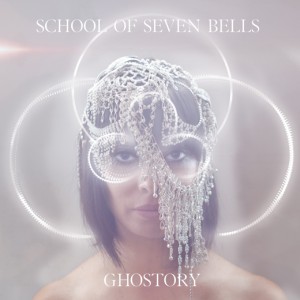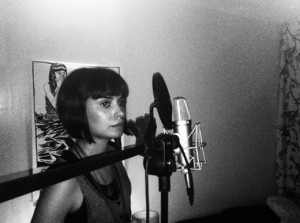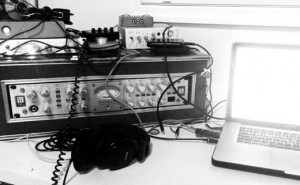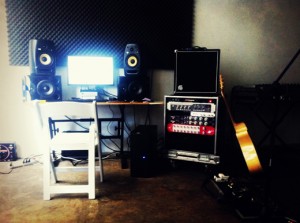Behind the Release: School of Seven Bells Recombine for “Ghostory”
WILLIAMSBURG, BROOKLYN: Of all the bands in the world, School of Seven Bells would be the last you’d ever expect to have a lineup change.

Seeing double -- and that's all: School of Seven Bells is Benjamin Curtis and Alejandra Deheza. (Photo credit: Justin Hollar)
But in October of 2010, something unthinkable to the fans of this Brooklyn-borne source of rhythmic entrancement happened: Claudia Deheza – one-half of the twin sister duo that fronted SVIIB – quit the group. While on tour.
No doubt her bandmates, sibling singer Alejandra and guitarst/electronic manipulator Benjamin Curtis, were the most shocked by her sudden exit, but the band’s devoted fans weren’t far behind in being blindsided. Much of the magic of SVIIB’s music – a psychological alchemy of harmonies, beats, guitars, atmospheres, and newly discovered textures – lay in the connection that twins are legendary for.
With one of the family gone, it was quite reasonable to ask: Would anything be left?
The answer is revealed in School of Seven Bells’ new release, dropping this week, Ghostory. From the first distorted sparkles of the record’s opener, “The Night”, you realize there is much more in store for SVIIB. Its haunting beauty overtakes you in an instant, as Alejandra’s voice and words burst through the urgent backdrop that Curtis creates for her.
Is Alejandra singing to her sister, or simply to the rest of us on “The Night” and the eight enveloping tracks that follow? No matter the meaning of the lyrics, this is clear: Ghostory is a tale that would be told, no matter what.
Three Becomes Two
Before Alejandra and Curtis could begin the tracking and mixing of Ghostory, which was a far different process than they underwent for the two unforgettable albums that preceded them – 2008’s Alpinisms and 2010’s Disconnect from Desire (see the SonicScoop feature on the making of that album here)– they would have to recover from the blunt impact trauma of Claudia’s sudden departure. “The real blow was the timing,” Curtis recalls of that tough night in San Francisco. “We were touring, and she decided after a show that she really didn’t want to do it anymore. That was it. She was gone.
“We had our next TV appearance the next day. Alley and I said, ‘What do we do? Do we go home, or do this? Will people still want us?’ But we decided, ‘This is our band, and we love this music. We worked way too hard for anyone to ever take it away from us.’ We found our feet again, and in the process we rediscovered the fire that started the band. It was a creative rebirth, in the end.”
With a bandmate overboard, but their resolve intact, the remaining Deheza and Curtis finished the U.S. tour at hand and gigged extensively in Europe. Back home at their Greenpoint haunts, School of Seven Bells – now officially a duo – began writing again in February of 2011, a period when new songs began to arrive in full force.
A Different Demo Process
The demo recordings commenced, and it was clear then that things would be very different indeed with Ghostory. “The Disconnect from Desire writing process was similar to Alpinisms,” says Curtis, “in that we slowly constructed the songs until they were finished. This time around, because we felt so confident as songwriters, the ideas was to write a song, demo it, and then record the song.
“That’s so traditional, but we’ve never ever done it. The point was that we knew we wanted this record to be so much more direct and emotional. We wanted it to rely on performance, rather than collage. So we laid them down, and really learned to play them before we recorded them. That’s what every band on the planet does, but for us it’s a novel concept.”
One factor that helped make SVIIB’s previous albums stand out was the band’s unorthodox practice of recording Alejanda and Claudia’s rhythmically interwoven vocal parts first in the process, then building the rest of the song’s musical components around them. “What we learned from that is something we still carry with us,” Curtis notes. “For us, the point in doing that is that we know we like to write music and songs together, but we don’t know what that is yet. So it was like, ‘We have a song idea, let’s record the vocals, and then let the music tell the story.’ We arrived at the sound of SVIIB, and that’s where it came from.
“For Ghostory the approach was really similar, but the difference is that we arrived at arrangements quickly. We still put down a demo vocal early and played with it, but now we allow for a musical idea to be present a lot earlier on, or an instrumental melody or lead instrument. That’s what’s really different about Ghostory, is there’s lots of instruments playing melodically important parts, instead of just being textures.”
As the songs for Ghostory began to unfold, the pair locked into a routine. Deheza would show up to Curtis’ apartment every day at 11 AM and work until 3 PM (“We pretended we had a real job”), working with Curtis’ simple setup: Logic running on his suped up “Hackintosh”, guitars, a Neumman U87 mic, and a Virus Indigo synth – plus a pair of ‘80’s analog keyboards that provided renewed inspiration.
“I had an Ensoniq ESQ-1, and I got a Roland D-50 just for the synth pads. It’s kind of fun if you go into the patches. They have those sampled attacks, but if you take those out some of the pads are really grainy, especially if you stretch the envelopes really far. You get some strange textures. I’m not sure if those synths are supposed to do what they did, but in some of the intro textures of the songs you can hear that, like in the beginning of ‘The Night’ and ‘Scavenger.’
“When you’re working with instruments like that, the accidents are so fun. The Ensoniq doesn’t react to MIDI correctly, for example. That bubbly, bouncy synth that’s happening all through ‘When You Sing’ is that — it’s just taking the notes and stuttering like that, because it’s basically fucking up. It’s the perfect part. I love music when I feel I wasn’t responsible for it, because it’s better than what I came up with.”
Recording “Ghostory”
Demos in hand, SVIIB dove into the recording process for Ghostory. Curtis once again handled the task of engineering the vocal recordings himself, capturing Deheza’s voice in his Williamsburg apartment, a music-friendly residence which happens to be the former living quarters of TV On the Radio’s Dave Sitek — complete with vocal booth.
Curtis’ signal path for Deheza was the aforementioned Nuemann U87 running through an Avalon 737 mic pre, then on into a Sparrow two channel interface from Black Lion Audio. “I’m learning so much all the time,” says Curtis of his evolution as an engineer. “Just all the things I’ve had to correct in the end, I’m learning to take care of. Like proximity to the microphone: If something is going to sound distant, just finding great ways to move the mic away. I’m learning how to record us really well. I may not be useful to anybody else, but I like to think I’d transfer the knowledge somehow.
“The vocal recording process was a lot more free and easy, because we didn’t have to stop to teach anybody parts. It was just me hitting record, and Alley kind of going for it. It’s really streamlined — we definitely didn’t feel like there was something missing at all. We were just going. Alley’s voice has gotten stronger and stronger over years, and I could just listen to her on a mic all day.”
The powerful, swirling collages of guitars, synths and bass that equally define SVIIB’s sounds were also recorded by Curtis at the band’s studio space in Williamsburg, working off of a Black Lion Audio mobile recording/mixing rig fashioned by his brother Brandon Curtis, who maintains his own visibility as the keyboardist for Interpol.
“We took a lot more care getting the sounds correctly,” Benjamin says. “Brandon has been doing a lot of production with bands, and I bounced ideas off of him. I did a lot more positioning with microphones, using multiple mics and getting a lot more room sounds, which is definitely a big change for this record.”
Another notable shift for SVIIB’s avid listeners will be the addition of real drums, an element which brings a different drive to six Ghostory songs: “The Night,” “Lotons,” “When You Sing,” “Scavenger,” “White Wind,” and “Lafaye.” Engineer Geoff Sanoff tracked SVIIB’s live touring drummer Chris Colley at the East Williamsburg studio My Active Driveway.
“We’d been blasting the demos in the van constantly, so Chris got to know them really well,” explains Curtis. “We had a six day break, so we popped into the studio and laid down the drum tracks really quickly. There’s no desk in My Active Driveway, but as a far as microphones, preamps, and compressors, it’s like a kid in a candy store – so beautiful and so much great stuff. It was amazing.
“There’s a particular energy, and a manic, aggressive feeling/quality that you can really only get from a guy beating the shit out of some drums in a room. We also recorded drums for the songs ‘Love Play’ and ‘Show Me Love,’ but I actually wound up going back to an electronic approach for those. It was just a dimension I missed. There’s a dimension you get with electronic sounds that music can’t get otherwise. It’s a color, and everything is there to tell the story of the song better.”
Experience Ghostory right now (and buy the album if you like what you hear).
Mixing in SoHo
Although a Brooklyn band through and through, School of Seven Bells has been known to step outside of the Broken Land to mix. Disconnect from Desire was mixed in L.A. by elite mixer Jack Joseph Puig, and Ghostory took place across the river in the lofty spaces of Manhattan’s SoHo district.
Working in a huge, empty room kindly donated to the band by the creative advertising agency Wieden + Kennedy, the Curtis brothers settled in with Brandon’s Black Lion audio-modded Digi 003 rig, mixing virtually 100% in the box save for the occasional application of Empirical Labs’ Distressors and a loop through the Black Lion PM8 summing mixer.
“I really wanted to collaborate with Brandon again,” Benjamin says of the mix phase. “We’d been on tour together, and there’s no one on the planet that’s seen us play more. I knew he would want to be there and make sure that what SVIIB sounds like was coming out of the speakers. He started the mixes while on tour with Interpol in Europe, then came back in September and finished them up in that room.
“I think the mix that Jack Joseph Puig did is incredible, and he’s such a talented guy. But I don’t think it’s a boast to say that you listen to Ghostory, that you won’t say, ‘Wow, that record sounds so digital!’ Where does that leave us? It means you can do a great mix anywhere, and it’s kind of up to your ears. I don’t mean to sound like I’m discounting anyone’s years of experience: It’s an art, and hard work, to mix a record. Some people would have done it quicker, but I think we just had to do it this way.”
School of Seven Bells swung back to the familiar for the mastering stage, working with Joe Lambert in DUMBO just as they did for Alpinisms and Disconnect from Desire.
“It’s an interesting thought,” Curtis reflects on the importance of consistency in the choice of mastering engineer. “I think you have to have somewhere to go where someone will take care of the music first of all, and Joe has a lot of love for the bands he works with. He’s so into the music he’s listening to: You look over, and he’s rocking out. We knew going in that he would be finicky about it – Joe’s probably put up with us more than anybody else, and he’s great at it.”
In addition to digital, Lambert was once again asked by SVIIB to cut a vinyl edition, an extra step that Curtis is increasingly passionate about taking. “I just like the fact that it’s a physical object that is trapped in time,” he states. “It’s going to be here forever. If a solar storm wipes out everything digital, this record will not disappear. But I love the way the packaging looks. I love the way it smells. I don’t know if it’s nostalgia, but when you’re holding the record, that’s when you feel like you’ve made something. I don’t feel that way when I download it.”
Catching Ghosts in Action
School of Seven Bells is a band that has been captivating ears since its first album. Alpinisms was a breathtaking work that arrested the ears with its massive originality, then deeply intrigued all who learned the DNA backstory that drove the group. Then Disconnect from Desire delivered on the promise of what could come next as the trio’s creativity evolved.
The next step should have been logical, but fate had other plans for this band. With one human element now noticeably missing, SVIIB had to see if their sound was something greater than the sum of their parts.
“Ghostory is particularly important in the history of School of Seven Bells – that’s why we made it so quickly,” Benjamin Curtis observes. “It was time, we were inspired, and we had to get it out. The more music we make, I feel it’s completing the picture.
“Ghostory is a great snapshot of us right now. It’s the music I want to hear, and I can’t help but think that I’m not completely unique: There are probably other people out there like me. Hopefully this record will do it for them.”
Ghostory is available February 28th on Vagrant Records/Ghostly International.
— David Weiss
Please note: When you buy products through links on this page, we may earn an affiliate commission.










